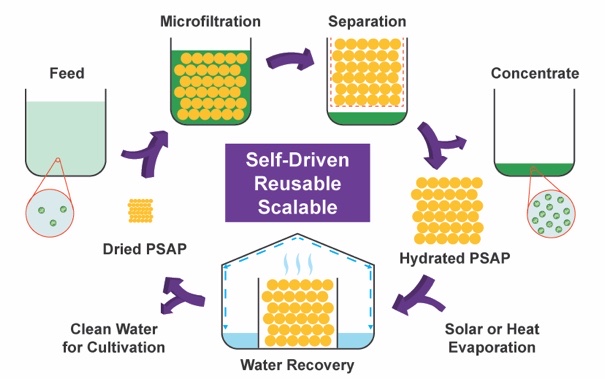These porous superabsorbent polymer (PSAP) beads enable a fast, scalable, and cost-effective method for harvesting microalgae. Designed and fabricated by researchers at Georgia Tech, they could improve upon standard methods for harvesting microalgae, which are expensive and time and labor-consuming. PSAP beads are SAP frameworks distributed with numerous physical pores, enabling up to 10 times greater concentration over standard methods. When immersed in an aqueous solution, water quickly fills the physical pores and wets the pore surface of the beads, significantly increasing the contact area between the polymer network and water molecules for fast water uptake. While the beads swell to absorb water far beyond their own weight, they exclude microalgae outside the bead—enabling microalgae to be harvested in the residual concentrated liquid without the use of complex instruments, such as centrifuges and pumps. This technology also eliminates the need for specialized techniques or added chemicals.
- Fast: The optimized pore structure of the PSAP beads allows fast and selective absorption of water, greatly reducing standard processing time.
- Cost effective: Microalgae harvesting with PSAP beads cuts costs, as it does not require any complex instrument and little training is needed to operate the harvesting procedures.
- Scalable: PSAP beads can be produced in large quantities at a significantly lower cost than conventional harvesting tools.
- Efficient design: The water absorption capacity of the PSAP beads is up to 10 times greater than standard methods and requires only a volume of beads.
- Reusable: After harvesting, the hydrated beads can be easily separated from the concentrated microalgae and regenerated for multiple reuses.
This technology is designed to enable the efficient harvesting of microalgae cultures used for:
- Sustainable energy as a biofuel alternative
- Biodiesel
- Bioethanol
- Agriculture
- Feedstock
- Wastewater treatment
- Bioproducts as a resource for pharmaceuticals
- Carotenoids
- Antioxidants
- Pigments
- Polyunsaturated fatty acids
Microalgae—rapidly growing organisms with high photosynthetic efficiency—are emerging as next-generation sustainable, renewable, and economical resources. They have extensive potential to address urgent industrial and agricultural demands, offering ease of scale-up with no arable land requirement. Their high contents of lipids and carbohydrates make them compatible for feedstock and to produce biofuels, such as biodiesel and bioethanol. Microalgae are also feasible sources of various high value bioproducts such as polyunsaturated fatty acids, carotenoids, pigments, and antioxidants. The feasibility of using microalgae in advanced wastewater treatment has been investigated for its highly efficient removal of nutrients from municipal, agricultural, and industrial wastewater.
However, there are still many obstacles that must be overcome for large-scale industrialization and commercialization of microalgal production and processing. One of the most challenging and crucial issues is microalgae harvesting—an issue the harvesting method with PSAPs from Georgia Tech helps address.

An illustration of the life cycle for introducing dry PSAPs to an aqueous solution to harvest microalgae from the residual concentrated liquid.
